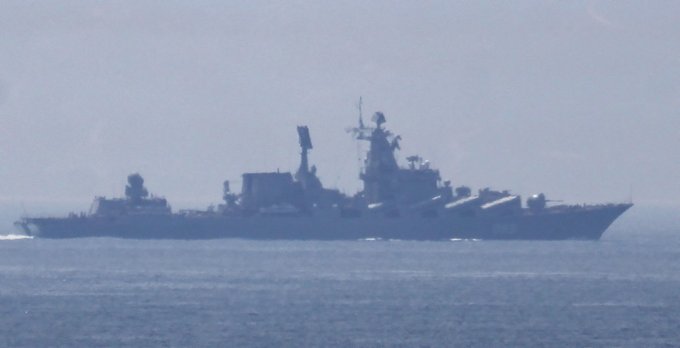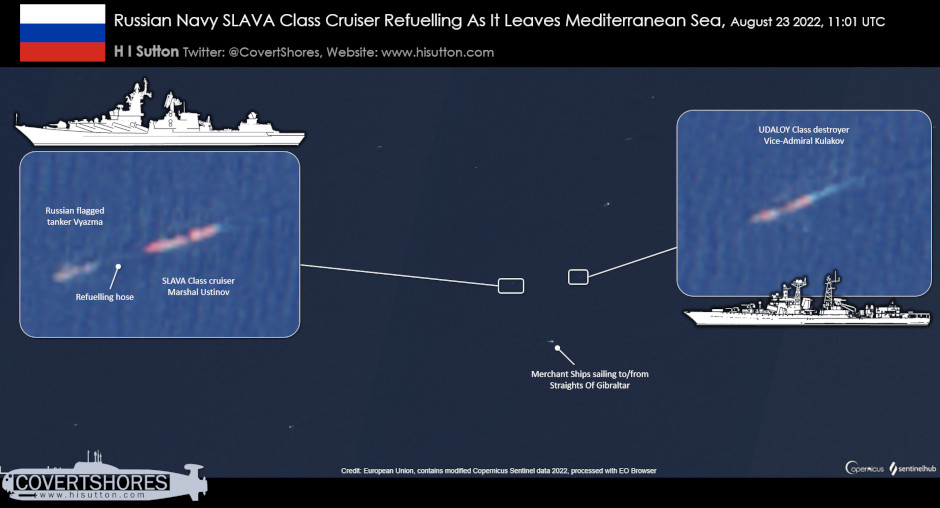
The sister ship of the Russian guided-missile cruiser sunk by the Ukrainian Navy has left its position in the Mediterranean Sea after six months, USNI News has learned.
RTS Marshal Ustinov (055), sister ship to the former RTS Moskva (121), passed through the Strait of Gibraltar on Thursday after operating in the Mediterranean Sea since early February, according to ship spotters. Shortly after it passed into the Atlantic two U.S. guided-missile destroyers assigned to the Harry S. Truman Carrier Strike Group, USS Cole (DDG-67) and USS Bainbridge (DDG-96), followed the Russian cruiser two hours after it passed the Rock of Gibraltar, according to photos published by ship spotters. The cruiser was one of Russia’s primary naval assets in the region and reduces Moscow’s presence closer to Ukraine.
Ustinov, along with the Russian Navy’s two other Slava-class cruisers – the sunken Moskva and RTS Varyag (011) – were sortied from their homeports earlier this year in conjunction with the Russian ground invasion of Ukraine.
Ustinov, part of the Russian Navy’s Northern Fleet, entered the Mediterranean in early February as the head of a surface action group and took up station off the southern coast of Crete while the Pacific-based Varyag operated closer to Syria and the Russian logistics base in Tartus, USNI News reported at the time.

The deployments ran in parallel to the NATO and U.S. presence operations centered on USS Harry S. Truman (CVN-75), its escorts and embarked air wing. Truman has been in the Mediterranean since December and its air wing has flown up to 90 sorties a day.
Designed in the 1970s to take on U.S. carriers with 16 telephone pole-sized SS-N-12 Sandbox anti-ship cruise missiles, the Slava-class ships have endured as part of the Russian fleet following the end of the Cold War.
Two Ukrainian Neptune anti-ship guided-missiles attacked and sank Moskva in April. USNI News reported in May that the cruiser likely sank because its point defense radars were not operational.
While the U.S. has an extensive logistics footprint in the region, Russian resupply and refueling has been harder, according to USNI News contributor H I Sutton.
USS COLE DDG67 & USS BAINBRIDGE DDG96 heading west through the Strait of Gibraltar this afternoon #shipsinpics #ships #shipping #shipspotting @air_intel @The_Lookout_N@YorukIsik @WarshipCam @seawaves_mag@NavyLookout @arleighburke511 #USNavy pic.twitter.com/pXKAxiuhVL
— Daniel Ferro (@Gibdan1) August 24, 2022
“The Russian navy does not have meaningful maintenance facilities in the Med. We can speculate that crew fatigue from longer periods of heightened readiness may be a factor,” in their departure, he wrote.
Sutton published satellite photos showing Ustinov refueling on Tuesday ahead of its departure from the region.
Meanwhile, the George H.W. Bush Carrier Strike Group has entered U.S. 6th Fleet. USS George H.W. Bush (CVN-77) departed Naval Station Norfolk, Va., on Aug. 10 and is expected to relieve Truman in the coming days.
Truman has been deployed for eight and half months.





